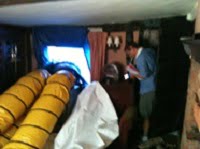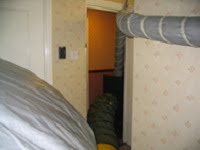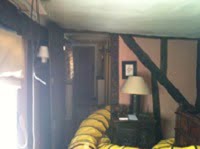Alternative Approaches to the Eradication of Wood Destroying Insects
The use of chemical insecticides has been a safe and reliable method of controlling wood destroying insects when they are discovered in the built environment. The formulations commonly used by the professional building preservation industry have been tried and tested over many years.
Insecticides work on the basis that the target insect is affected by a chemical compound that kills or terminally disrupts its lifecycle. Contact insecticides like Permethrin, stomach poisons such as compounds of Boron and “Flurox”, a growth regulator, all rely on the insect eating or coming into very close contact with the introduced chemical compounds. The surface application of an insecticide is very effective against the lifecycle of the insect when chemical treatment is applied to the timber on all surfaces.
When timbers are embedded in masonry, are inaccessible, historically very sensitive or extremely large in dimension, then this can become a challenge to achieve any form of control of insect infestations using surface applied chemicals.
This can be overcome in some circumstances with the use of spirit-based liquid insecticides or oil or glycol based pastes, however, using these products can cause problems with odours, surface residue and staining.

In recognising these performance limitations and in reaction to the “chemical free” treatment lobby, elements of industry have periodically explored alternatives to liquid chemical preservatives.
In August this year, the PCA were invited by Thermokil Ltd to attend a practical experiment at treating a building affected by Death Watch beetles – Xestobium rufovillosum. The owner of the 300 year old timber-framed cottage initially contacted a Preservation contractor after seeing and hearing adult beetles last spring. The contractor recommended only a surface application of insecticides to exposed timber elements, but, following some research into this suggestion, the client/owner realised that this approach would most likely be very ineffective. The contractor had offered to issue a 20 year guarantee based on a very limited and poorly conceived treatment programme.
Thermokil Ltd was given the opportunity to carry out an alternative approach of heat treatment – the purpose of this practical. The heating equipment was set up and temperature sensors placed strategically throughout the building. Temperature and humidity sensors were set up in each room and within the sections of the exposed timbers frame. Heat was applied through ducts from a diesel powered heating rig located in the car park. This continued for almost 18 hours until it was considered that target structures had reached at least 52 degrees centigrade for two hours.

The key question is did it work? The answer – we don’t know. The application of heat into the building was impressive and the temperatures achieved in the exposed timbers appeared to exceed the minimum required to kill insects at all life stages. The damage to the structure and finishes caused by the hot air appeared to be negligible and the disturbance to the homeowners relatively short lived.
Though a number of questions about heat transfer in damp wood and the effects on timber with differing density appear to have been positively resolved by the data logged through the process, a number of unanswered questions remain. Temperature sensors sited in the timber beam ends, where they were built into masonry walls, showed that it was very difficult to heat embedded timbers to a sufficient temperature. As a result, serious questions remain about the temperature achieved in timbers concealed by plaster ceilings or in positions that link internal and external surfaces such as built-in timber wall plates and timber lintels. One major advantage with chemical insecticides is they are residual and remain active for years after application. This is not the case with heat treatments where it is essential that the most likely reservoirs of infestation within the confines of the timber are heated to lethal levels. The author remains doubtful that this was achieved throughout the building.
The fact is that the fabric of the building became very hot. The insects exposed to this level of heat will probably have been killed effectively, however only time will prove if the process was successful after a number of flight seasons have passed without evidence of any further signs of adult insect emergence.
Another alternative treatment is now available is certain circumstances. We understand Sulfuryl fluoride (a highly poisonous fumigant gas) has now been granted a licence for the use against wood destroying insects in buildings.

The registration allows: ‘for the remedial control of infestations of wood destroying pests such as termites, powder post beetles, furniture beetles, European house beetles in dwellings, building furnishings (house hold effects), constructions, packaging materials, historical monuments and wooden artefacts.’ The gas is highly toxic to mammalian life and so must be applied by qualified fumigators. The gas is subject to controls on its usage which means that is unsuitable for use in all but a small number of domestic and industrial situations.
The eradication of wood destroying insects in difficult to treat situations, historic structures and deep within large timbers has always been a challenge to the custodians of buildings over many centuries. Though we understand about the target insect and the timber they inhabit and how to affect control, it seems that we will continue to experiment with the issue for some time yet.